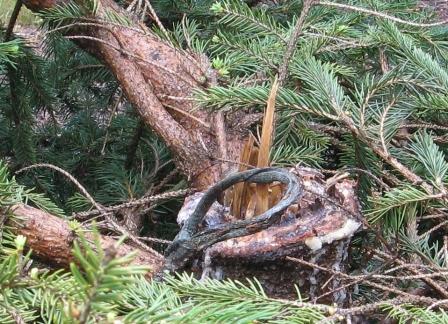The photo below (graciously sent to me by former MSU Extension Educator Jennie Stanger) graphically illustrates the importance of removing ALL staking and supporting materials from trees once they are established.

Just a matter of time (Photo: Jennie Stanger)
In this case the stakes were removed but the strapping material was left around the tree. Since this is a spruce, Jennie supposes no one wanted the prickly job of wading into the center of the tree to take off the strap. Eventually the trunk was girdled and when the area recently experienced some heavy thunderstorms, the weak spot on the tree was exposed.

Stately evergreen to mangled mess (Photo Jennie Stanger)
As a general rule we recommend that all staking and support materials are removed within two years, preferably one year. This type of damage is one of the prime reasons: after two years who is likely to remember that there is still strapping left on the tree?


